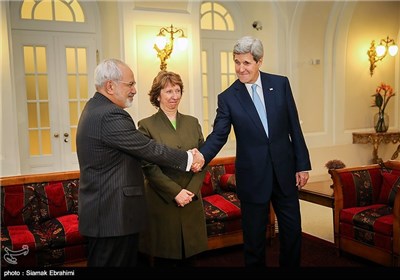 Iranian Foreign Minister Mohammad Javad Zarif, former EU Foreign Policy Chief Catherine Ashton and U.S. Secretary of State John Kerry pose for photographers at nuclear talks in Vienna on Thursday. AGENCE FRANCE-PRESSE/GETTY IMAGES[/caption]
Iranian Foreign Minister Mohammad Javad Zarif, former EU Foreign Policy Chief Catherine Ashton and U.S. Secretary of State John Kerry pose for photographers at nuclear talks in Vienna on Thursday. AGENCE FRANCE-PRESSE/GETTY IMAGES[/caption]Among all the issues in the Iranian nuclear talks with six major powers, theres one question that wont go away.
Its not whether a framework nuclear deal will be ready by end-March or whether any likely agreement will sell out key western or Iranian negotiating red lines. The question thats been debated among the core group of reporters that have long followed the talks is: What has happened to Catherine Ashton?
Ms. Ashton, the European Unions former foreign policy chief, had played an important role in the nuclear talks. She presided over the group of six countries negotiating with Iran and was, for four years, the direct contact point with Tehran in the timing, format and framework of diplomacy.
Ms. Ashton and her EU team played a key role in keeping negotiations going during the tense days of 2012 and early 2013 when it seemed Iran was headed inexorably toward nuclear break-out capacity and a possible military conflict.
She also played a notable role in the November 2013 interim nuclear agreement with Iran, keeping Washington in sync (more or less) with its international partners in the group of six the U.K., Russia, China, France and Germany.
When Ms. Ashtons Brussels role ended on Oct. 31, 2014, it was already agreed she would remain as chair of the six-power group until what was then the deadline for talks Nov. 24. When diplomats missed that deadline and diplomacy was extended a second time, there was a struggle behind the scenes about Ms. Ashtons role.
In theory, her position should have been taken over by the EUs new foreign policy chief Federica Mogherini. But although Ms. Ashton had tried the patience of some of her six-power colleagues, many felt it wiser if she kept her liaison role as all sides pushed to meet a new target date of end-March 2015 to seal the political framework of a deal.
A typical Brussels compromise emerged as Ms. Ashton pressed to stay involved, according to people familiar with discussions. Ms. Mogherini would take formal responsibility for the EU in the talks but Ms. Ashton would continue her role as a special advisor on Iran. Ms. Mogherini will join talks only when all other foreign ministers from Iran and the six powers are involved a relatively rare occurrence.
That seemed clear. Only one problem. Since the last day of the November talks in Vienna, Ms. Ashton has not been seen.
While many of the negotiation rounds since then have been at bilateral level most frequently between the U.S. and Tehran Irans Foreign Minister Javad Zarif has been present much of the time. In the past, when Mr. Zarif turned up, Ms. Ashton was there.
The EU has had someone on the ground. Helga Schmid, the EUs political director who has been involved in the talks on-and-off for a decade, meets with her six-power colleagues, liaises with Iran and is usually invited to US-Iranian bilaterals.
U.S. and European officials say Ms. Ashton remains involved. A U.S. official said she remains in touch with Secretary of State John Kerry now and again on the negotiations. European officials say she has contacts with other players as well from back home in Britain.
Yet others acknowledge Ms. Ashton has pretty much faded from the scene. Two western officials involved in the talks said they had not heard a peep from Ms. Ashton since Nov. 24 by email, telephone or otherwise. Ms. Ashton declined a request to comment.
A third senior European diplomat summed the situation up. Ms. Ashton, the person said, was a potentially valuable political resource in the weeks after the Nov. 24 deadline passed and a new EU team got up and running. It doesnt mean you necessarily have to use that resource, the person said.
By The Wall Street Journal










